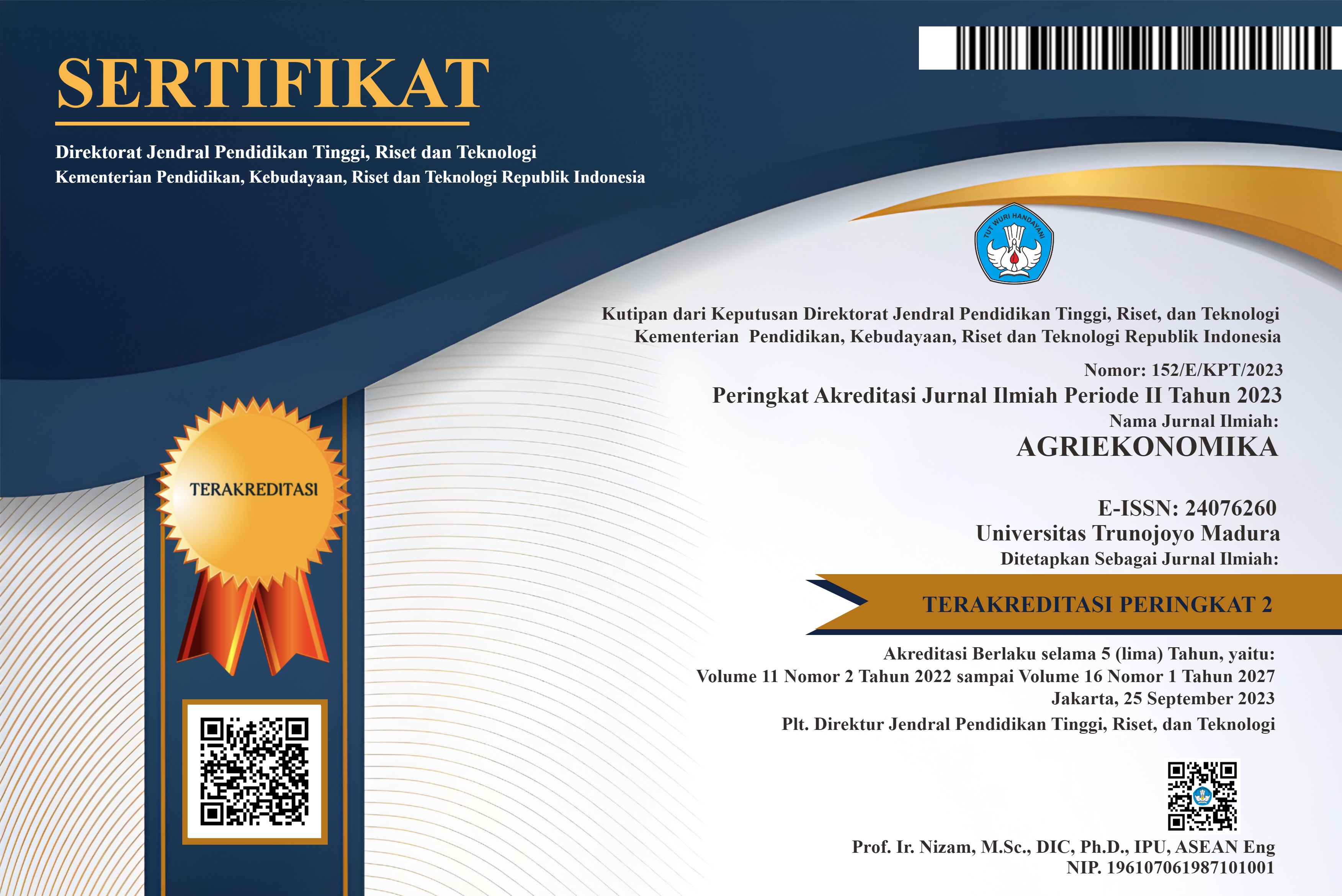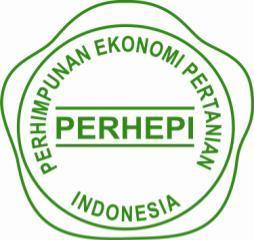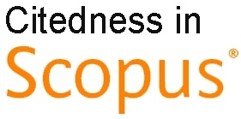Sustainable Food Reserve Program as Policy Intervention for Food and Nutrition Security in East Java, Indonesia: Roles of Officials and Local Actors
Abstract
This paper analyses the implementation of a sustainable food reserve program that empowers the community by mitigating the adverse impacts of malnutrition in Indonesia. This paper adopted an actor- and institution-centered communication approach to analyze the stakeholders, directly and indirectly, engaged in implementing the program. East Java province was selected as the sample of the study. Results of the analysis show that the communications of actors and institutions played dominant roles in the program implementation. In the early implementation stage, the dominant roles of actor and institution communication were strongly required in a new program intervention to guarantee smooth implementation. Government officials played a significant communication role at the provincial level. At the grassroots level, the main actors were women leaders of household prosperity education and farmer leaders. Agricultural extension officials dominantly communicated between provincial and grassroots levels. Institutions must start reducing dominant roles and appointing local cadres to replace and reduce dependency on the institutions.
Keywords
Full Text:
PDFReferences
ADB. (2011). Global Food Price Inflation and Developing Asia. Asian Development Bank.
Aji, T. S., & Shiolihah, M. (2017). Dampak program kawasan rumah pangan lestari (KRPL) terhadap pengeluaran konsumsi rumah tangga (Studi Kasus Di Desa Pucangsari Kecamatan Purwodadi Kabupaten Pasuruan). Agromix, 4(2), 17–21.
Black, R. E., Victora, C. G., Walker, S. P., Bhutta, Z. A., Christian, P., de Onis, M., Ezzati, M., Grantham-McGregor, S., Katz, J., Martorell, R., & Uauy, R. (2013). Maternal and child undernutrition and overweight in low-income and middle-income countries. Lancet, 382(9890), 427–451.
Cole, D. C., Levin, C., Loechl, C., Thiele, G., Grant, F., Girard, A. W., Sindi, K., & Low, J. (2016). Planning an integrated agriculture and health program and designing its evaluation: experience from Western Kenya. Evaluation and Program Planning, 56(1), 11–22.
DKP. (2015). Food Security and Vulnerability Atlas of Indonesia 2015. Kementerian Pertanian and World Food Programme.
Haskas, Y. (2020). Gambaran stunting di Indonesia: literatur review. Jurnal Ilmia Kesehatan Diagnosis, 15(2), 17–27.
Hermans, L. M., & Thissen, W. A. H. (2009). Actor analysis methods and their use for public policy analysts. European Journal of Operational Research, 196(2), 808–818.
Indah, P. N., Amir, I. T., & Khasan, U. (2020). Empowerment of urban farming community to improve food security in Gresik. Agriekonomika, 9(2), 150–156.
Kampman, H., Zongrone, A., Rawat, R., & Becque, E. (2017). How Senegal created an enabling environment for nutrition: a story of change. Global Food Security, 13(1), 57–65.
Kennedy, E., Fekadu, H., Ghosh, S., Baral, K., Davis, D., Saptoka, D., & Webb, P. (2016). Implementing multisector nutrition programs in Ethiopia and Nepal: challenges and opportunities from a stakeholder perspective. Food and Nutrition Bulletin, 37(4), 115–123.
Kuswanti, I., & Azzahra, S. K. (2022). Hubungan pengetahuan ibu tentang pemenuhan gizi seimbang dengan perilaku pencegahan stunting pada balita. Jurnal Kebidanan Indonesia, 13(1), 15 – 22.
Latifah, E., Andri, K. B., & Mariyono, J. (2014). Pengenalan model kebun sayur sekolah untuk peningkatan konsumsi sayuran bagi para siswa di Kediri - Jawa Timur. Agriekonomika, 3(1), 34–44.
Mariyono, J. (2018). Empowering rural livelihoods through farmers’ field school on vegetable production in Aceh Province-Indonesia. Journal of Rural Development, 37(1), 129–145.
Mariyono, J. (2019). Stepping up from subsistence to commercial intensive farming to enhance welfare of farmer households in Indonesia. Asia & the Pacific Policy Studies, 6(2), 246–265.
Marks, G. (1996). An actor‐centred approach to multi‐level governance. Regional & Federal Studies, 6(2), 20–38.
Meijer, A. (2016). Coproduction as a structural transformation of the public sector. International Journal of Public Sector Management, 29(6), 596–611.
Mekusen, A. (2003). An actor-centered approach to regional economic change. Annals of the Association of Economic Geographers, 49(5), 415–428.
Mitchell, R. K., Agle, B. R., & Wood, D. J. (2017). Toward a theory of stakeholder identification and salience: defining the principle of who and what really counts. Academy of Management Review, 22(4), 853–886.
Mj, T. E. L. (2018). Keberhasilan program kawasan rumah pangan lestari (KRPL) dan pemberdayaan perempuan (kasus: kelompok wanita tani (KWT) Desa Cikarawang, Kecamatan Dramaga, Kabupaten Bogor, Provinsi Jawa Barat). Institut Pertanian Bogor.
MOA. (2013). National Nutrition Strategy Paper of Indonesia, Directorate General of Food Security Agency. Ministry of Agriculture.
Nasriati, Novrianty, E., & Yani, A. (2018). Level of participation of women’s group member (KWT) in the model program of some food household home (m-krpl) in Sidodadi Village, Way Lima District, Pesawaran Regency.
Oka, I. G. A. D. S., Darmawan, D. P., & Astiti, N. W. S. (2016). The success of sustainable food houses program on women farmers group in Gianyar. Jurnal Manajemen Agribisnis, 4(2), 133–146.
Petersohn, B., Behnke, N., & Rhode, E. M. (2015). Negotiating territorial change in multinational states: party preferences, negotiating power and the role of the negotiation mode. Publius: The Journal of Federalism, 45(4), 626–652.
Purwami, I., Irawati, M. H., Rohman, F., Susilowati, S., & Budiasih, E. (2018). Program kawasan rumah pangan lestari (KRPL): analisis pengetahuan lingkungan dan sikap peduli lingkungan santri pondok pesantren di Kecamatan Gading Kabupaten Probolinggo. Bioeksperimen, 4(2), 16–21.
Ramadhani, S. (2022). Tingkat adopsi petani terhadap program KRPL (kawasan rumah pangan lestari) dan hubungannya dengan karakteristik social ekonomi petani (Studi kasus: kelurahan Jati Utomo, Kecamatan Binjai Utara, Kota Binjai).
Sari, R. P., Rosnita, R., & Yulida, R. (2016). No Title. Dinamika Pertanian, 32(3), 189–202.
Scharpf, F. W. (2017). Games Real Actors Play: Actor-Centered Institutionalism in Policy Research. Westview Press.
Shand, R. (2014). Community management of regeneration projects in Potsdam, Germany. International Journal of Law and Management, 56(3), 171–183.
Shrimpton, R., & Rokx, C. (2013). The Double Burden of Malnutrition in Indonesia, Report 76192-ID. World Bank.
Sukanata, I. K., Budirokhman, D., & Nurmaulana, A. (2015). Faktor-faktor yang mempengaruhi pemanfaatan lahan Pekarangan dalam kegiatan kawasan rumah pangan lestari (Studi kasus di KWT Dewi Srikandi Desa Cipanas Kecamatan Dukupuntang Kabupaten Cirebon). Agrijati, 28(1), 1-16.
Sundari, R. S., Umbara, D. S., Hidayati, R., & Budhi Wahyu Fitriadi. (2021). Peran Penyuluh Pertanian terhadap produksi padi sawah di Kabupaten Tasikmalaya. Agriekonomika, 10(1), 59–67.
Swasono, M. A. H., & Cholilah, N. (2017). Dampak program KRPL (kawasan rumah pangan lestari) terhadap pola pangan harapan (PPH). Agromix, 4(2), 22–28.
Syam, D., Saputri, N. A., & Widyastuti, A. (2018). Analisis added value program kawasan rumah pangan lestari (KRPL) terhadap ekonomi rumah tangga (studi kasus pada kelompok wanita tani dewi sri kota Batu). Jurnal Inovasi Ekonomi, 3(2), 72-83i.
Tama, J. (2017). The politics of strategy: why government agencies conduct major strategic reviews. Journal of Public Policy, 37(1), 27–54.
Tando, E. (2018). Optimalisasi pemanfaatan pekarangan melalui pengembangan model kawasan rumah pangan lestari (KRPL) dalam mendukung penerapan teknologi budidaya sayuran organik di Sulawesi Tenggara. Agroradix, 2(1), 14–21.
Tyas, D. N. A. (2019). Implementasi kebijakan program kawasan rumah pangan lestari (KRPL) dalam meningkatkan kesejahteraan masyarakat. Jurnal Inovasi Ilmu Sosial Dan Politik, 1(1), 71–87.
Wardoyo, A. S., Waluyo, S., & Karyanto, K. (2013). Pemanfaatan pekarangan dan teras rumah di tengah kota sebagai suatu kawasan rumah pangan lestari (KRPL) studi di Kelurahan Arjosari Kecamatan Blimbing Kota Malang.
Wijaya, Andy Fefta, Kuntariningsih, A., Sarwono, S., & Suryono, A. (2021). Role and contribution of vegetables in mitigating malnutrition through a sustainable food reserve program. International Journal of Vegetable Science, 27(1), 65–75. https://doi.org/10.1080/19315260.2019.1703872
Wijaya, Andy Fetfa, Kuntariningsih, A., Sarwono, S., & Suryono, A. (2021). Malnutrition mitigation and community empowerment through the sustainable food reserve programme in Indonesia. Development in Practice, 31(1), 37–48. https://doi.org/10.1080/09614524.2020.1782845
DOI: https://doi.org/10.21107/agriekonomika.v12i1.17031
Refbacks
- There are currently no refbacks.







